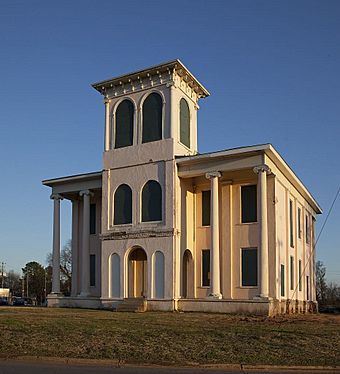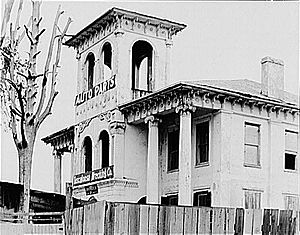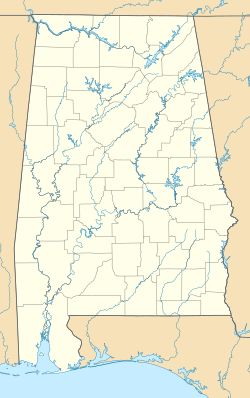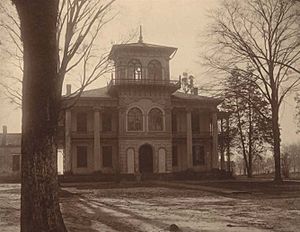Dr. John R. Drish House facts for kids
|
Jemison School-Drish House
(Dr. John R. Drish House) |
|

Drish House in 2010, with stabilization measures underway
|
|
| Location | 2300 17th Street, Tuscaloosa, Alabama |
|---|---|
| Built | 1837-1861 |
| Architectural style | Greek Revival, Italianate |
| NRHP reference No. | 14000357 |
Quick facts for kids Significant dates |
|
| Added to NRHP | March 17, 2015 |
The Dr. John R. Drish House, often called the Drish House, is a historic plantation house in Tuscaloosa, Alabama. It's known for its unique mix of Greek Revival and Italianate styles.
This special house was first studied in 1934. It was added to the Alabama Register of Landmarks and Heritage in 1975. Later, in 2006, it was listed as a "Place in Peril" because it needed repairs. In 2015, it was officially listed on the National Register of Historic Places as the Jemison School-Drish House.
Building the Drish House
The Drish House is a large brick mansion covered in stucco. It was built in 1837 for Dr. John R. Drish. The house was the center of a 450-acre (1.8 km2) property on the edge of Tuscaloosa.
Dr. Drish was from Virginia and was one of the first people to settle in Tuscaloosa in 1822. He was a successful doctor and also worked as a building contractor. Many skilled artisans, who were enslaved people, helped build the house. They were known for their excellent plasterwork in Tuscaloosa.
The first design of the house in 1837 is thought to be influenced by state architect William Nichols. The outside of the house had large Doric porches at the front and back. Two-story pilasters (flat columns) decorated each section on all four sides.
Before the American Civil War, the house was updated in the Italianate style. A three-story brick tower was added. The front columns were changed to the Ionic order, which are more decorative. Brackets were added under the roof edges, and two-story cast iron porches were built on each side. Dr. John Drish passed away in 1867, and his wife, Sarah Drish, died in 1884.
What Happened Next?
After Sarah Drish died, the mansion was owned by different people. The land around it was sold off and divided into smaller lots. This helped Tuscaloosa grow.
In 1906, the Tuscaloosa Board of Education bought the house. They opened the Jemison School inside it. The house was used as a school until 1925. After that, it was bought by Charles Turner's Tuscaloosa Wrecking Company. They used it as a warehouse for car parts. During this time, in 1935 or 1936, famous photographer Walker Evans took a well-known picture of the house. This photo is now displayed at the Metropolitan Museum of Art.
In 1940, the Southside Baptist Church bought the Drish House. They built a church sanctuary next to the house and a separate Sunday school building. The church owned the house for the rest of the 20th century.
The house was almost torn down in 1994. But instead, it was leased to the Heritage Commission of Tuscaloosa County in 1995. By 2006, the house was in bad shape. It was added to the "Places in Peril" list by the Alabama Historical Commission.
In 2007, the house was given to the Tuscaloosa County Preservation Society. This group worked to make the building stable. They hoped to raise money to restore it. In 2009, they had the church additions removed. In 2012, Nika McCool of Past Horizons LLC bought the Drish House. Renovations continued until May 2016, when it opened as a place for events.

Mysteries and Legends
Since the early 1900s, people have said the Drish House is haunted. It was even featured in a book called 13 Alabama Ghosts and Jeffrey by Kathryn Tucker Windham and Margaret Gillis Figh. The story about the house is called "Death Lights in the Tower."
Some people claim to have seen the third-story tower looking like it's on fire, even when there's no actual fire. Others have reported seeing mysterious lights coming from the house.




